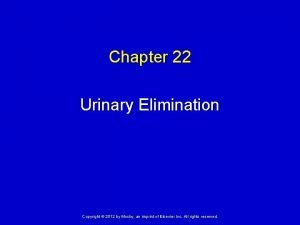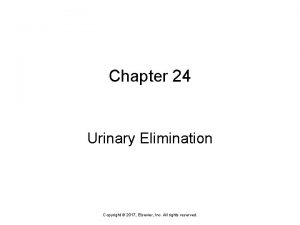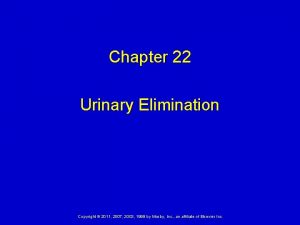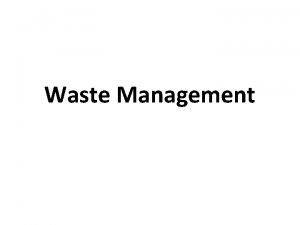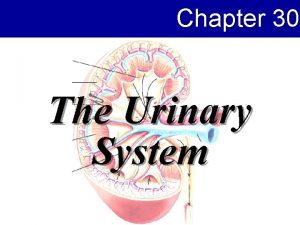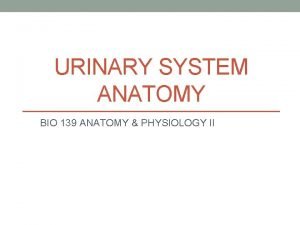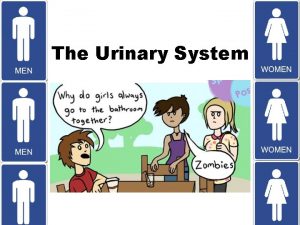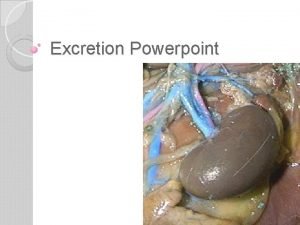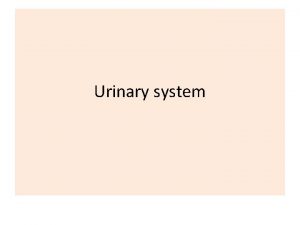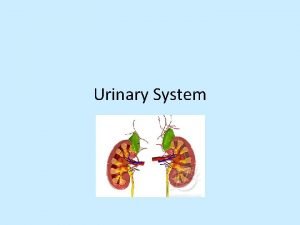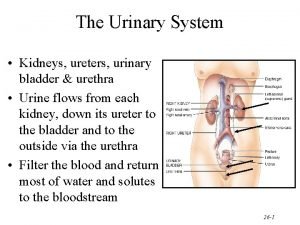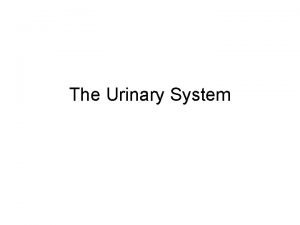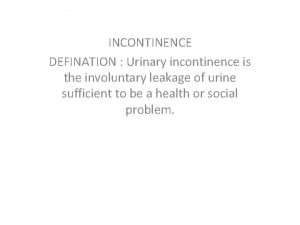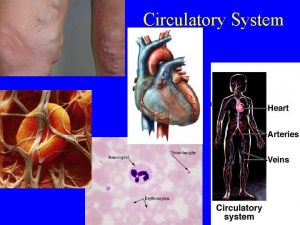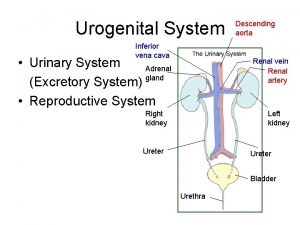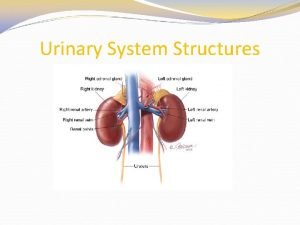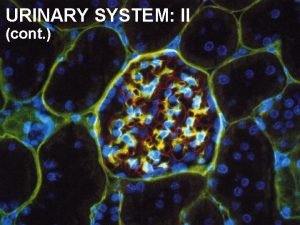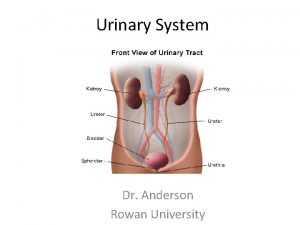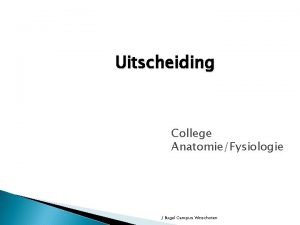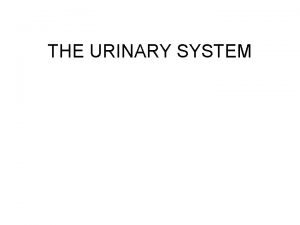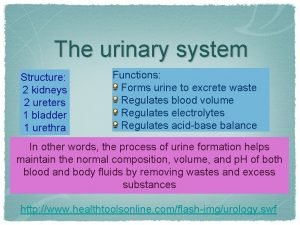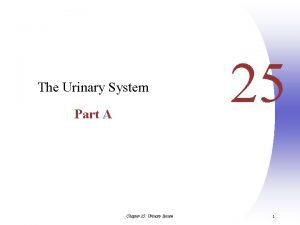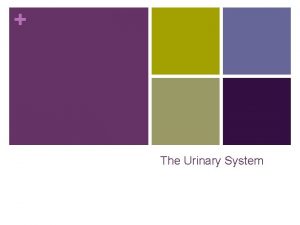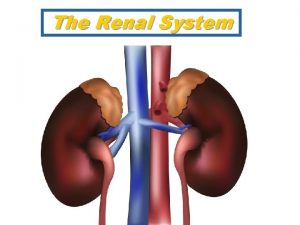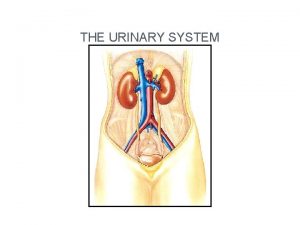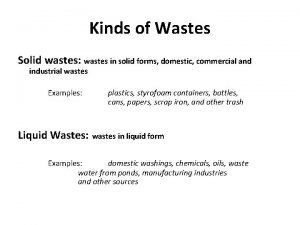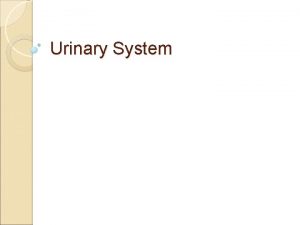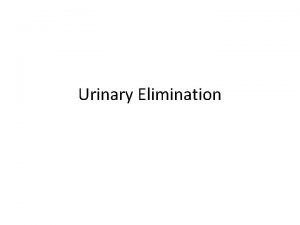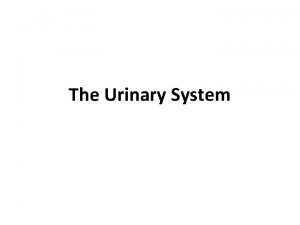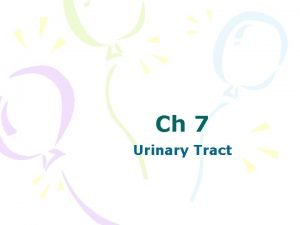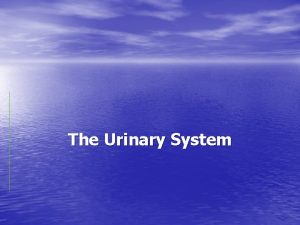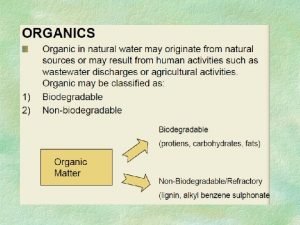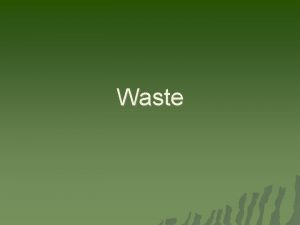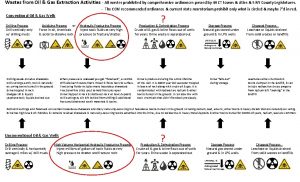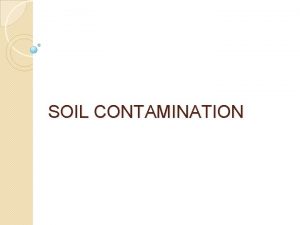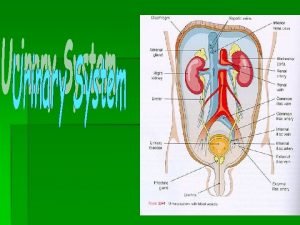Urinary Elimination Functions of Urinary System Remove wastes


















































- Slides: 50

Urinary Elimination

Functions of Urinary System § Remove wastes from blood to form urine § Remove nitrogenous waste products of cellular metabolism § Regulates fluid and electrolyte balance The nephron = functional unit of the kidney and forms the urine

Goal of Urinary System § To maintain chemical homeostasis of the blood. § Filtration by the Nephrons § H 2 O, glucose, amino acids, urea, creatinine, major electrolytes § Not normally large proteins or blood cells § Proteinuria is a sign of glomerular injury § Normal adult 24 hr output = 1500 -1600 ml.

Overview of Urinary System § Kidneys § Bean shaped organs § Either side of vertebral columns T 12 – L 3 § Right kidney lower due to liver § Urine produced with filtration of blood through nephrons § Major role in fluid & electrolyte balance


Anatomy of the Kidney

Nephron

§ Ureters § Connect kidneys to bladder § 10 -12 in length, ½ in diameter in adult § Peristaltic waves § Renal colic

§ Bladder § Distensible, muscular sac § Reservoir for urine ( approx. capacity = 600 mls ) § Organ of excretion ( norm. voiding= 300 mls) § Lies in pelvic cavity behind symphysis pubis

§ Urethra § Short, muscular tube § Urine from bladder to meatus and from the body § Female 4 -6. 5 cm (1 ½ - 2 ½ in. ) length § Male 20 cms ( 8 in. ) § Urinary and reproductive systems

§ Meatus § External opening of the urethra, male & female § The need to void is a conscious awareness

Formation of urine § STAGES IN URINE FORMATION: § § § 1. (Glomerular) Filtration 2. Reabsorption 3. Secretion

§ Nephron

1. Filtration -blood pressure forces small molecules from the glomerulus to the capsule Filtrates: glucose, amino acids uric acid, urea

2. Tubular Reabsorption -return of filtrates from blood at the proximal tubule through diffusion and active transport

3. Tubular Secretion -movement of molecules from blood into the distal convoluted tubule Molecules: drugs and toxins

Reabsorption of water -return of H 20 via osmosis along the loop of Henle and collecting duct

Excretion § Excretion of urine formed

Life Cycle Changes § Infants & children § Unable to concentrate urine - kidneys are immature § Urine is light yellow § Void frequently § Voluntary control at 24 mos. when neuromuscular structures develop

§ Adult § 1500 – 1600 mls urine/24 hrs § Concentrates urine – normal is amber colored § Nocturia § Not usually § Decreased renal blood flow during rest § Ability to concentrate urine

§ Elderly § Micturition impaired § mobility § Diseases, alzheimer’s, CVA § Physiological age related changes § Bladder loses muscle tone and capacity § Kidneys lose ability to concentrate urine § Bladder loses muscle strength

Alterations in Urinary Elimination Patterns § Urinary Retention § Accumulation of urine in the bladder § Inability to empty § Pressure, discomfort and tenderness § Residual Urine = urine retained in the bladder after voiding

§ Incontinence § Loss of voluntary control to void § Infection, nerve damage to bladder or brain, spinal cord injury, or aging process § Total incontinence = no control § Stress incontinence = small amount, Urine excreted involuntarily with coughing or laughing At risk for skin breakdown related to acid urine next to skin. Adult Diapers or Attends

§ § Frequency & Urgency Nocturia Enuresis – involuntary discharge of urine Nocturnal Enuresis § During sleep § Bed-wetting children 5 yrs and older § Oliguria § 30 mls/hr or 720 mls/24 hrs § Renal anuria § cessation of urine production 100 mls/24 h

Promoting Healthy Urinary Elimination § Urinate as soon as the urge is felt § Avoids stasis and distention § Prevents urgency, infection, and incontinence § Drink about 2 liters fluid/day § Limit Na, caffeine, and alcohol

§ For people with Nocturia § § § fld. Intake in the p. m. caffiene and alcohol Void before bedtime § For Women § § Wipe perineum front to back Void soon after intercourse Wash hands Pelvic – floor strengthening exercises (Kegel Exercises)

Client Education § § S & S of infection Fluid intake ( if no restrictions 2 -5 L/day ) Perineal hygiene Medicines & side effects on urination, color, and volume

What is Micturition? § It is the physiological term of "urination" i. e. the dispersion of urine from urinary bladder to the outside through urethra

Facilitating Micturition § Nursing Measures to promote voiding in people who are having difficulty: 1. 2. 3. 4. 5. Privacy and natural position Providing commode or bathroom Running water Warm water to dangle fingers Warm water over perineum (measure if on I&O)

6. Gently stroking inner thighs or pressure to symphysis pubis 7. Pain relief Warmth to the bladder & perineum relaxes muscles & facilitates voiding. ( Sitz bath or warm tub ) If unsuccessful- urinary catheterization may be indicated

§ Promoting complete bladder emptying § Prevention of infection § Good perineal hygiene § Adequate fld. Intake § Dilutes urine & flushes urethra § Acidifying urine ( inhibits microorganisms) § Cranberry juice, whole grain breads, meats, eggs, prunes and plums.

Urinary Catheter § A urinary catheter is any tube system placed in the body to drain and collect urine from the bladder. § A catheter can be used for short-term or long-term use. § Catheters come in many sizes, materials (latex, silicone, Teflon), and types (Foley, straight, coude tip).

Indications of Urinary Catheter § Urinary incontinence (leakage of urine or the inability to control when you urinate) § Urinary retention (being unable to empty the bladder when you need to) § Surgery that made a catheter necessary, such as prostate or gynecological surgery § Other medical conditions such as multiple sclerosis, spinal cord injury, or dementia

Types of Urinary Catheters

§ A Foley catheter (indwelling urinary catheter)/3 -Way Catheter is retained by means of a balloon at the tip that is inflated with sterile water. § A 3 -way catheter has 3 passageways – one is for urine to pass, one is for the inflation of the balloon and the other one is for instilling medications and therapeutic irrigations directly into the bladder.

§ The balloons typically come in two different sizes: 5 cm 3 and 30 cm 3. § They are commonly made in silicone rubber or natural rubber.

§ An indwelling urinary catheter is one that is left in place in the bladder. Indwelling catheters may be needed for only a short time, or for a long time. § These catheters attach to a drainage bag to collect urine. A newer type of catheter has a valve that can be opened to allow urine to flow out, when needed. An indwelling catheter may be inserted into the bladder in two ways:

§ (Most often) The catheter is inserted through the urethra, which is the tube that brings urine from the bladder to the outside of the body § Sometimes, the doctor will insert a tube, called a suprapubic catheter, into your bladder from a small hole in your belly. This is done as an outpatient surgery. § An indwelling catheter has a small balloon inflated on the end of it. This prevents the catheter from sliding out of the body. When it's necessary to remove the catheter, the balloon is deflated.

§ An intermittent catheter/Robinson catheter/Straight catheter is a flexible catheter used for short term drainage of urine. § Unlike the Foley catheter, it has no balloon on its tip and therefore cannot stay in place unaided. These can be noncoated or coated (e. g. , hydrophilic coated and ready to use).

§ An external, Texas, urisheat, or condom catheter is used for incontinent males and carries a lower risk of infection than an indwelling catheter.

§ A coudé catheter is designed with a curved tip that makes it easier to pass through the curvature of the prostatic urethra. § A hematuria (or haematuria) catheter is a type of Foley catheter used for Post. TURP hemostasis. This is useful following endoscopic surgical procedures, or in the case of gross hematuria.

§ Condom catheters are most frequently used in elderly men with dementia. There is no tube placed inside the penis. Instead, a condom-like device is placed over the penis. A tube leads from this device to a drainage bag. The condom catheter must be changed every day

§ Sometimes urine can leak around the catheter. This may be caused by: § Catheter that is blocked or that has a kink in it § Catheter that is too small § Bladder spasms § Constipation § The wrong balloon size § Urinary tract infections

Complications § § § Allergy or sensitivity to latex Bladder stones Blood infections (septicemia) Blood in the urine (hematuria) Kidney damage (usually only with longterm, indwelling catheter use) § Urethral injury § Urinary tract or kidney infections

Bladder Irrigation § Bladder irrigation is flushing out the bladder. § A tube called a urinary catheter is put into the bladder through the urethra. § The catheter is connected to a bag of sterile water or salt solution which flushes out any clots of blood after surgery.

Types of bladder irrigation 1. Closed method § Preferred technique for catheter or bladder irrigation. § May either be continuous or intermittent. § A 3 -way or triple lumen catheter is generally used.

2. Open method § There is an increased risk of injecting microorganism into the urinary tract. § It is performed with double-lumen indwelling catheter. § Strict precautions should be employed to maintain sterility of the drainage tubing connector & interior of indwelling catheter

Purposes in performing bladder irrigation: § To maintain the patency of a urinary catheter & tubing (continuous irrigation) § To free a blockage in a urinary catheter or tubing (intermittent irrigation)

Reasons of alteration of urinary system functions § Cancer § Conditions affecting the structures near the urinary tract § Infection § Inflammation § Injury § Nervous system diseases § Scarring of UT § Urine crystallization

Major manifestations of urinary system disorder § Abdominal, pelvic, or lower back pain or discomfort; § Blood in the urine; § Changes in the urine; difficulty producing urine; § Fever and chills; § Frequent urination; § Leaking of urine; and urgent need to urinate.
 Chapter 22 urinary elimination
Chapter 22 urinary elimination Chapter 24 urinary elimination
Chapter 24 urinary elimination Chapter 22 urinary elimination
Chapter 22 urinary elimination Nur 102
Nur 102 Alterations in urinary elimination
Alterations in urinary elimination Gaussian elimination
Gaussian elimination Lymphatic system organs and functions
Lymphatic system organs and functions Mare chicose landfill
Mare chicose landfill Water that contains waste from industry or homes
Water that contains waste from industry or homes 9 wastes
9 wastes 8 wastes examples
8 wastes examples Nuclear wastes
Nuclear wastes Nuclear wastes
Nuclear wastes Seven wastes of lean
Seven wastes of lean Seven wastes lean
Seven wastes lean What are nitrogenous wastes
What are nitrogenous wastes Wireless charging wastes energy
Wireless charging wastes energy Introduction of urinary system
Introduction of urinary system Chapter 15 urinary system
Chapter 15 urinary system Chapter 11 urinary system medical terminology
Chapter 11 urinary system medical terminology Intugementary
Intugementary Bladder fetal pig
Bladder fetal pig The urinary system chapter 30
The urinary system chapter 30 Chapter 15 the urinary system figure 15-3
Chapter 15 the urinary system figure 15-3 Chapter 20 urinary/excretory system
Chapter 20 urinary/excretory system Urinary system model
Urinary system model Urinary system model
Urinary system model Placoid scales definition
Placoid scales definition Urinary system powerpoint
Urinary system powerpoint Renal system
Renal system Function of antidiuretic hormone
Function of antidiuretic hormone Nephron urinary system
Nephron urinary system Figure 15-4 is a diagram of a nephron
Figure 15-4 is a diagram of a nephron Prone
Prone Defination of urine
Defination of urine Homework
Homework Rat appendix
Rat appendix Rat urinary system
Rat urinary system Vena cava excretory system
Vena cava excretory system Figure 15-4 is a diagram of a nephron
Figure 15-4 is a diagram of a nephron Urinary system
Urinary system Does the urinary system regulate blood pressure
Does the urinary system regulate blood pressure Urinary system
Urinary system Composition of urine slideshare
Composition of urine slideshare What is the name
What is the name Normal constituents of urine
Normal constituents of urine Urinary system
Urinary system Kidney system diagram
Kidney system diagram Urinary system root words
Urinary system root words Renal lobe and lobule
Renal lobe and lobule Arneriole
Arneriole
